Abstract
The Cheremkhovo formation (Pliensbachian) is the primary coal-bearing formation of the Irkutsk basin, Eastern Siberia. Still, few geochemical studies of the Jurassic sediments of the Irkutsk coal-bearing basin have been conducted, and there are no data on the geochemistry of the coal-bearing formation itself. This study presents geochemical data for 68 samples from the Cheremkhovo formation and the overlying Lower Prisayan formation. The age of the former has been estimated by U-Pb dating of zircon from a tonstein (altered volcanic ash) layer as Pliensbachian, whereas the age of the latter is estimated as Pliensbachian–Toarcian according to regional stratigraphy. Major oxide and trace element concentrations were obtained using X-ray fluorescence spectrometry. Geochemical indicators showed diversity between the two studied formations. The indicators used show the change in climate conditions, from warm and humid in the Cheremkhovo formation, to hot and arid during the deposition of the lower Prisayan formation. The provenance of the Irkutsk coal-bearing basin was mainly influenced by the source composition, not recycling, and sediments were mainly derived from felsic to intermediate igneous rocks with a mixture of other rock types.
1. Introduction
The Irkutsk coal-bearing basin is located in the southern part of the Siberian Craton (Figure 1). A large fuel and energy complex has been created in the region; about 15 million tons of coal are mined annually. On the Russian scale, it provides 6% of coal production [1].
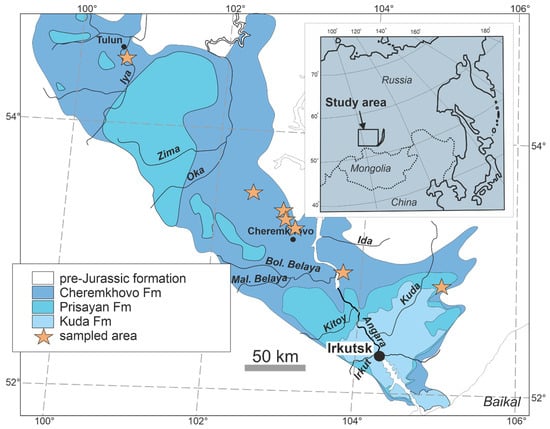
Figure 1.
Schematic map showing the distribution of the Irkutsk coal-bearing basin sediments in the southern part of the Siberian craton.
The regional stratigraphic chart for the basin sediments was accepted in 1981 with the Cheremkhovo, Prisayan, and Kuda formations [2]. The Cheremkhovo formation (Fm.) is the primary coal-bearing formation of the Irkutsk basin. Based on biostratigraphy, different scholars attribute the Cheremkhovo Fm. to the Pliensbachian [3], Pliensbachian–Toarcian [2,3,4] or Pliensbachian–Aalenian [5] intervals. The only radioisotopic date (187.44 +0.45/−1.60 Ma, Pliensbachian) was obtained by the U-Pb method using laser ablation inductively coupled plasma mass spectrometry (LA-ICP-MS) on zircon of a tonstein (altered volcanic ash) layer from an industrial coal seam of the Azeysk deposit [6]. According to [3], whose stratigraphic scheme is consistent with U-Pb data, the Prisayan Fm. and Kuda Fm. are Pliensbachian–Aalenian and Aalenian–Bajocian, respectively.
Despite the large number of publications devoted to studies of the Irkutsk coal-bearing basin [3,4,5,7,8,9,10,11], there are too few modern analytical data for this area. In recent years, the study of the Irkutsk coal-bearing basin was focused on stratigraphy, structural evolution, and sedimentology [5,11,12,13,14,15,16]. Geochemical data were only obtained for coals of the Azeisk coal deposit [17] and the uppermost Prisayan Fm. and Kuda Fm. [11,12,18].
On the global scale, the Toarcian is marked by an ocean anoxic event (Toarcian-OAE) [19], which in turn likely resulted from Karoo-Ferrar flood basalt volcanism [20,21]. To see the probable changes in the volcanic-related environmental conditions, we provide a detailed geochemical study of sediments of the Cheremkhovo Fm. and Lower Prisayan Fm., i.e., those formations which, on the one hand, were formed before, at, and after the Toarcian-OAE, but, on the other hand, were not yet studied.
1.1. Geological Setting
The Jurassic stratigraphy of the Irkutsk basin is compiled in Figure 2, using data from geological surveys [22,23] and Skoblo et al. [3]. The basis of the Jurassic sediments is represented by the 30 m- to 240 m-thick Cheremkhovo Fm. It is overlain by the 135 m- to 350 m-thick Prisayan Fm. The Jurassic sediments compete with the up to 145 m-thick Kuda Fm. The alluvial, the alluvial–deluvial, the floodplain, and lacustrine-boggy facies are distinguished by the basin sediments [7,8].
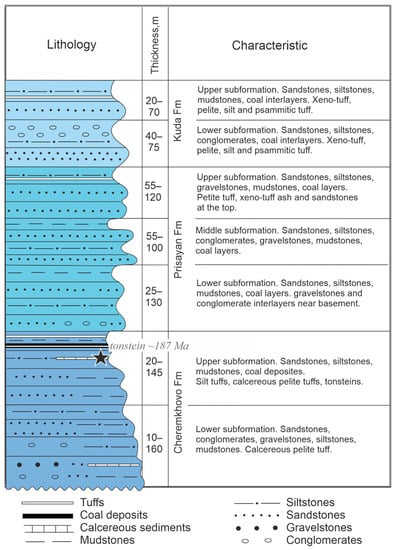
Figure 2.
Lithology column of the Jurassic sediments of the Irkutsk coal-bearing basin. The black star marks the tonstein dated on zircon by U-Pb laser ablation inductively coupled plasma mass spectrometry (LA-ICP-MS) [6].
1.2. The Lower Cheremkhovo Formation
The lower Cheremkhovo Fm. is mostly coarse-grained and composed of sandstones, gravelstones, conglomerates, and thin layers of siltstones, mudstones, and coal. The subformation thickness is from 100–130 m to 30 m, up to full thinning [24]. The lower Cheremkhovo Fm. indicates the transitions from widespread coarse-grained facies to clay-brecciated and sand facies [3,7,8,25]. Facies depend on sedimentation conditions, the buried morphology, and provenance. The clay-brecciated facies is not more than 20 m [23] thick. The average thickness of the sand facies is 10–16 m, up to 30 m [23]. Both of these facies are limited within the Irkutsk basin. The widespread coarse-grained facies building up the basal part of the Jurassic section extended over almost the entire area of the basin. Samples were collected in order to cover the widespread coarse-grained facies of the lower Cheremkhovo Fm.
The lower Cheremkhovo Fm. is exposed in the area of Zalari town (53°34′09.14″ N, 102°32′37.74″ E) (Figure 3). The base of the section is unconformably overlying the Cambrian rocks. The section consists of well-sorted pebble to boulder conglomerates. The conglomerates are interlayered with beds of well-sorted sandstones, varying from fine-grained to gravel. The composition of the pebbles is controlled by quartzites, quartz with granitoids. Pebbles are characterized by a good degree of roundness. The polymict sandstones consist of badly sorted minerals (quartz, calcite, plagioclase, and feldspar) and rock pieces (quartzite, gneisses, and granite). Clast roundness is from medium to good. The matrix is of clay and iron oxide particles intermixed with the clay. The siltstone composition is close to that of sandstone.
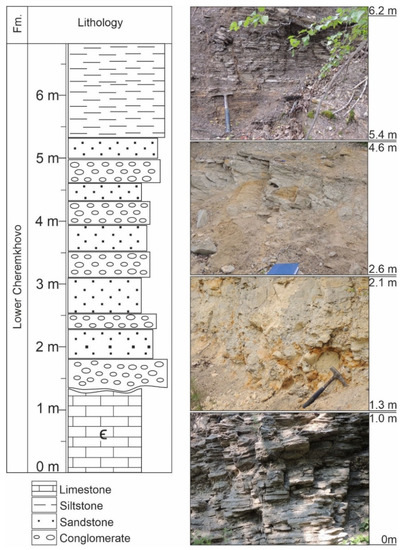
Figure 3.
Section of the lower Cheremkhovo formation (Fm.) sampling in the area of Zalari town.
The lower Cheremkhovo Fm. is exposed in the area of Kutulik village (53°22′02.14″ N, 102°47′02.30″ E) (Figure 4). The deposits are composed of sandstones and siltstones. The polymict and feldspar–quartz sandstones consist of poorly sorted mineral grains (quartz, feldspar, and plagioclase) and rock pieces (quartzite, felsic volcanic rocks, gneisses, and granite). Mineral grains and rock pieces are characterized by varying degrees of roundness, from poor to good. The matrix is composed of clay and iron oxide particles intermixed with the clay. The siltstone composition is close to that of sandstone.

Figure 4.
Section of the lower Cheremkhovo Fm. sampling in the area of Kutulik village.
1.3. The Upper Cheremkhovo Formation
The upper Cheremkhovo Fm. is composed of siltstones, mudstones, industrial coal, and sandstones. All coal deposits known in the Irkutsk basin are associated with the upper Cheremkhovo Fm. The Irkutsk basin coals are mostly lower rank; metamorphism increases in the northwest direction to the southeast [23]. The second-highest stage of metamorphism is characterized by coals of the southeastern part of the basin, but there are no coal deposits that would be economic to mine.
The upper Cheremkhovo Fm. samples were collected at the Cheremkhovo, Golovinsk, Bozoy, and Azeisk coal deposits. The sampled sections of the Cheremkhovo (53°15′15.27″ N, 102°57′09.06″ E) and Golovinsk (53°26′51.21″ N, 102°53′58.48″ E) coal deposits are almost the same (Figure 5). The deposits are composed of coals, mudstones, siltstones, and sandstones. The arkose and feldspar–quartz sandstones consist of badly sorted minerals (quartz, feldspar, and plagioclase) and rock fragments (volcanic rocks, gneisses and granite, and quartzite). Mineral grains and rock pieces are differentiated by roundness, from poor to good. The matrix is composed of clay. The siltstone composition is close to that of sandstone.
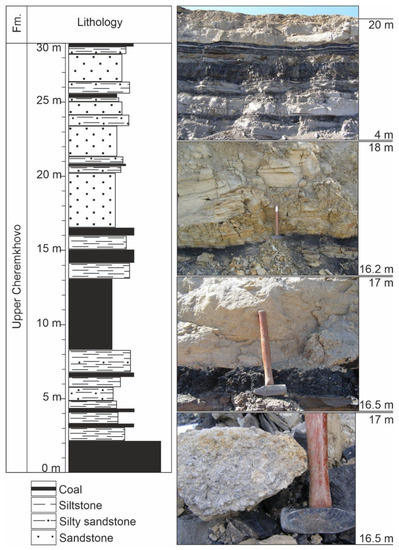
Figure 5.
Section of the upper Cheremkhovo Fm. sampling in the area of the Cheremkhovo and Golovinsk coal deposits.
The Bozoy section (52°52′01.16″ N, 105°02′28.37″ E) is represented by coals, mudstones, siltstones, and sandstones (Figure 6). The feldspar–quartz sandstones are composed of badly sorted minerals (quartz, feldspar, and plagioclase) and rock pieces (volcanic rocks, gneisses, granite, and quartzite). The fragments are differentiated by varying degrees of roundness, from poor to good. The matrix is composed of iron oxide particles intermixed with the clay. The siltstone composition is close to that of sandstone.

Figure 6.
Section of the upper Cheremkhovo Fm. sampling in the area of the Bozoy coal deposit.
1.4. The Lower Prisayan Formation
According to Skoblo et al. [3], the lower Prysayan Fm. is Pliensbachian–Toarcian. The lower Prisayan Fm. is composed of sandstones, siltstones, and gravelstones with a thin inter-bed of mudstones, conglomerates, and coals.
The lower Prisayan Fm. was sampled along the Angara river’s starboard side below the village of Ust-Baley (52°37′34.51″ N, 103°58′08.27″ E; Figure 7). The section is represented by sandstones with beds of pebbles and siltstones. The composition of pebbles is dominated by felsic effusive rocks, with a few granitoids and metamorphic rocks. Pebbles are characterized by a good degree of roundness. The quartz–feldspar and feldspar–quartz sandstones consist of badly sorted minerals (quartz, feldspar, plagioclase, and mica) and rock pieces (felsic volcanic rocks, granite, gneisses, and quartzite). Clasts differ by varying roundness, from poor to good. The matrix is composed of iron oxide particles intermixed with clay, and clay. The siltstone composition is close to that of sandstone. At different stratigraphic levels of the Irkutsk basin, especially in the Prisayan Fm., beds or nodules with a high calcite concentration occur.
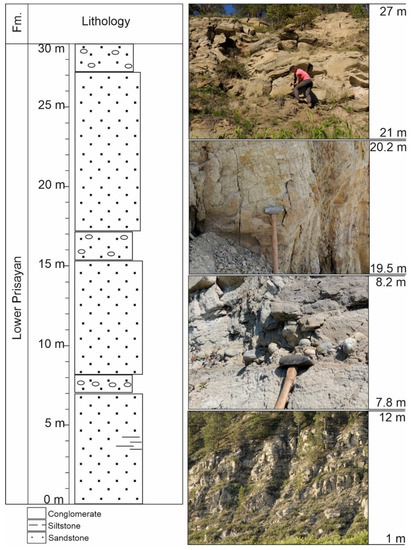
Figure 7.
Section of the lower Prisayan Fm. sampling in the area of Ust-Baley village.
2. Materials and Methods
The studied material comes from natural outcrops and sections of the Cheremkhovo, Azeysk, Golovinsk, and Bozoy deposits. The sampling locations are shown in Table S1. The petrographic analysis was carried out on sedimentary rocks and conglomerate pebbles.
Sample preparation and the analytical procedures were performed at the Center for Geodynamics and Geochronology of the Institute of the Earth’s Crust, Siberian Branch of the Russian Academy of Sciences (Irkutsk). The samples were crushed, split, and pulverized to a powder. Major element oxide (SiO2, Al2O3, Fe2O3, TiO2, MnO, MgO, CaO, K2O, Na2O, P2O5) and trace element (Ni, Cu, Ga, Pb, V, Cr, Co, Ba, La, Ce, Nd, Sm, Ta, Sc, Cs, As, Br, Nb, Zr, Y, Sr, Rb, Th, U) concentrations were analyzed by wavelength dispersive X-ray fluorescence (XRF) with an S8 TIGER (Bruker AXS GmbH, Germany) X-ray spectrometer using SPECTRAplus software after the procedures described in [26,27]. This method was chosen because of the low cost and high speed of the total analytical procedure, compared to other multielement analytical methods.
3. Results
This study presents geochemical data on the Jurassic deposits of the Cheremkhovo and lower Prisayan formations from the Irkutsk coal-bearing basin. Major element oxide and trace element data for the samples are given in Table S1. The Irkutsk basin’s sediments reveal a wide range of major element oxides, with SiO2 and Al2O3 being the dominant constituents. The concentration of SiO2 is from 40.93 to 88.24% in the Cheremkhovo Fm. and from 53.12 to 75.57% in the lower Prisayan Fm. The concentration of Al2O3 is from 3.92 to 23.13% in the Cheremkhovo Fm., and from 12.91 to 20.92% in the lower Prisayan Fm. The concentration of Fe2O3 ranges from 0.69 to 19.32% in the Cheremkhovo Fm., and from 1.75 to 13.99% in the lower Prisayan Fm. In sporadic samples the concentration of CaO is very high, more than 6.60%. We associate such CaO concentrations with nodules that occur at different stratigraphic levels of the Irkutsk basin section. Other major element oxides, such as K2O, TiO2, MgO, Na2O, and P2O5, are present in low concentrations (≤4.05%). In order to geochemically characterize the studied deposits of the Irkutsk coal-bearing basin, we did not use carbonate-rich sediments (CaO ≥ 10%), metasomatized or metamorphosed sediments [28].
3.1. Chemical Classification
The samples from the Cheremkhovo and lower Prisayan formations have different ratios of SiO2/Al2O3, and geochemical classification suggests that they cluster tightly in the graywacke, arkose, and litharenite fields. The Cheremkhovo Fm. samples fall in the graywacke, arkose, and litharenite fields [29]. The lower Prisayan Fm. samples fall in the graywacke field. The low SiO2 and ratios of SiO2/Al2O3 content demonstrate the immaturity of the Irkutsk basin sediments and suggest short transport distances between the major source regions and the sedimentary basin. The samples exhibit differences in Na2O/K2O ratios, especially in the lower Prisayan Fm. The group of the lower Cheremkhovo Fm. samples (six points) has very low log (Na2O/K2O) values from −1.44 to 1.26, and was not included in the classification diagram of Pettijohn [29] (Figure 8).
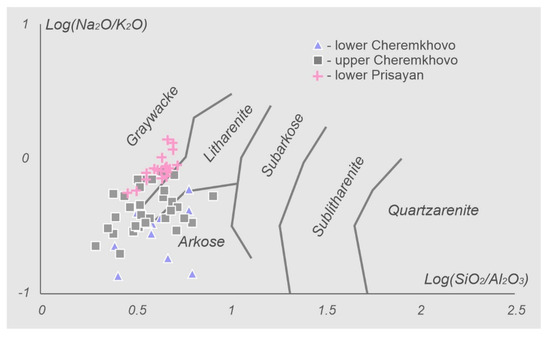
Figure 8.
Chemical classification of sandstones in the Irkutsk coal-bearing basin, based on their major element compositions (after [29]).
3.2. Weathering and Paleoclimate
The rate of chemical weathering of rocks and the erosion rate of weathering profiles is controlled by climate as well as source rock composition and tectonics. It is well known that chemical weathering strongly affects the major element geochemistry and mineralogy of siliciclastic sediments [30,31,32]. Several chemical indices have been proposed to quantify the intensity of weathering [28,30,31,32,33,34,35,36]. The chemical index of alteration (CIA) proposed by Nesbitt and Young [30] is widely used to check the degree of chemical weathering in rocks and as a marker of palaeoclimate. The CIA ratio can be calculated as: CIA = Al2O3/(Al2O3 +CaO1 + Na2O + K2O) × 100 [30]. The plagioclase index of alteration (PIA) is a CIA modification [32]. This can be calculated as: PIA = 100 × (Al2O3 − K2O)/(Al2O3 + CaO1 + Na2O − K2O). CaO1 represents the quantity of CaO integrated in the silicate fraction, and can be determined using the McLennan et al. method [31], where CaO1 = CaO − (10/3 × P2O5).
As shown in Figure 9, the CIA values for all samples varied from 51.47 to 90.23. The CIA values of the lower Cheremkhovo Fm. samples ranged from 51.47 to 84.27 (average value 75.68), from 64.14 to 90.23 (average value 80.81) for the upper Cheremkhovo Fm., and from 81.78 to 66.90 (average value 72.17) for the lower Prisayan Fm. We see that the Cheremkhovo Fm. samples show intense weathering and the lower Prisayan Fm. shows moderate weathering. The PIA values for the Cheremkhovo Fm. were quite high, ranging from 51.93 to 98.65, and offering high chemical weathering with hot and humid conditions. The smallest average PIA is seen in the lower Prisayan Fm. (80.74). The PIA values of the studied samples suggest intense chemical weathering. For most samples, the PIA and CIA values match well and indicate a comparable weathering grade (Figure 9). In the group of the lower Cheremkhovo Fm. samples, the PIA and CIA values do not match well. This group also has very low log (Na2O/K2O) values in the classification diagram (Figure 8).
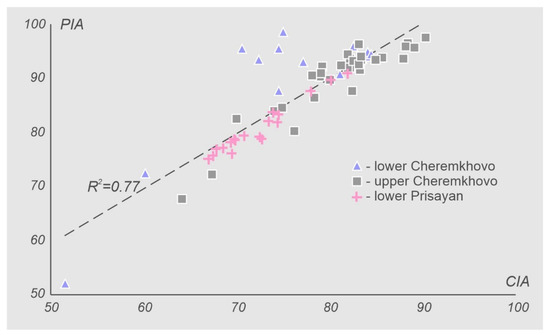
Figure 9.
The plot of the chemical index of alteration (CIA) versus the plagioclase index of alteration (PIA).
Th/U ratios rise with increasing weathering. The Th/U ratios of the lower Cheremkhovo Fm. samples ranged from 0.6 to 4.0 (average value 2.1), from 1.9 to 4.5 (average value 3.0) for the upper Cheremkhovo Fm., and from 1.9 to 4.0 (average value 2.8) for the lower Prisayan Fm. (Figure 10). At the plot of Th versus Th/U, we can see that samples from the Irkutsk basin did not suffer from strong weathering. Low Th/U ratios may characterize coal-bearing samples, with the wide U content bonded with an organic agent [37,38]. The Th/U ratios to set weathering degrees for the Irkutsk basin samples seem to be problematic, but such values in the Irkutsk basin sediments may indicate a simple cycling history.
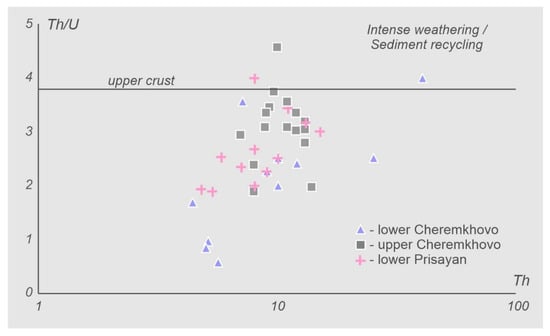
Figure 10.
Th versus Th/U plot (after [39]).
Variations in Rb/Sr and Sr/Cu ratios are applied to represent palaeoclimatic conditions. The Sr/Cu ratios of the lower Cheremkhovo Fm. samples ranged from 2.6 to 5.2 (average value 4.2), and from 9.2 to 15.3 (average value 12.9) for the lower Prisayan Fm. samples (Figure 11). Rb/Sr ratios demonstrated minor diversities, with all samples having values from 0.1 to 2.7 (Figure 11). The smallest Rb/Sr values are seen at the lower Prisayan Fm. (average value 0.3). Sr/Cu ratios rise under drier conditions [40,41,42]. Rb/Sr ratios reduce under drier conditions, and rise under cold conditions, just as low ratios represent warm conditions [43,44]. We can see that Sr/Cu ratios increase and Rb/Sr ratios decrease from the upper Cheremkhovo Fm. to the upper part of the lower Prisayan Fm. section (Figure 11). This can reflect changing climate conditions from warm and humid to hot and arid.
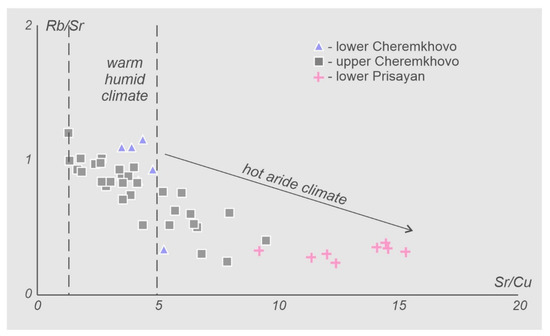
Figure 11.
Sr/Cu versus Rb/Sr plot. The trends of Sr/Cu and Rb/Sr ratios are from [43,44].
The geochemical data have shown the effect of climate fluctuations within the deposition of the Irkutsk coal-bearing basin deposits. In the Cheremkhovo Fm. a warm, humid climate prevailed and we see a high grade of chemical weathering of the source rocks. The indicators used represented changes in climate conditions within the deposition of the lower Prisayan Fm. At this time, climate conditions changed from warm and humid to hot and arid.
3.3. Source Composition and Provenance
The geochemical characteristics of sedimentary rocks can preserve provenance in-formation, despite the destruction of primary structures and alteration of minerals by sedimentary processes [39,45,46,47]. The ratio Th/Sc does not change considerably during sedimentary recycling [39], whereas the ratio Zr/Sc increases significantly. Thus, the ratios Th/Sc can be applied in tracing sedimentary provenance, and high Zr/Sc ratios can be considered indicators of zircon enrichment. On a Th/Sc–Zr/Sc diagram (Figure 12), the Cheremkhovo Fm. and lower Prisayan Fm. samples reflect a positive correlation between Th/Sc and Zr/Sc. The average Zr/Sc and Th/Sc ratios of the Cheremkhovo and lower Prisayan formations are 22.21 and 0.95. This pattern suggests that the provenance of these rocks was influenced by the source composition, not by sediment recycling [39].
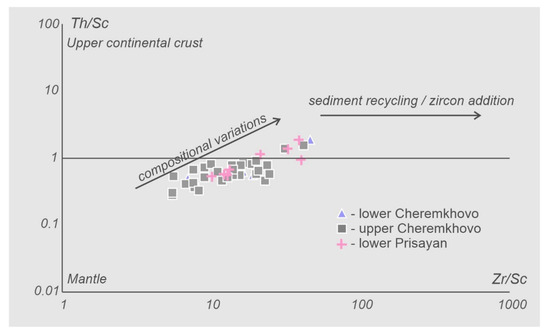
Figure 12.
The Zr/Sc versus Th/Sc plot (after [39]).
Major element contents record sediment recycling processes and the changing proportions of sedimentary and first-cycle source rocks which are shown by the index of compositional variability (ICV) [48]. The ICV can be calculated as: ICV = (Fe2O3 + K2O + Na2O + CaO + MgO + MnO + TiO2)/Al2O3 [48]. The ICV values of the upper Cheremkhovo Fm. range from 0.30 to 0.98, with an average value of 0.62. The ICV values of the lower Cheremkhovo Fm. range from 0.57 to 1.30, with an average value of 0.77. The ICV values of the lower Prisayan Fm. are higher and range from 0.69 to 1.52, with an average value of 0.97. The samples mostly lie between and along two trends, on either side of the fresh basalt line. Decreasing weathering to moderate values in the lower Prisayan Fm. demonstrates an increase in the ICV values to immature parameters (ICV > 1, by [46]) (Figure 13). Samples with ICV > 1 were deposited in tectonically active settings. On the other hand, ICV < 1 are mature and were deposited in a tectonically quiescent environment [48].
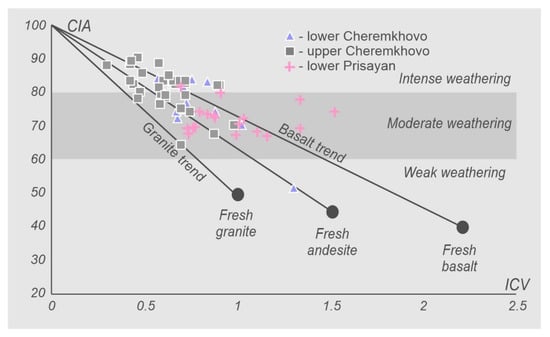
Figure 13.
The plot of the index of compositional variability (ICV) versus CIA. The trends of granite, andesite, and basalt are from [49].
K2O and Rb are substantially sensitive to sedimentary cycling and are generally used as indicators of the source rock composition [50]. The average K2O values are 2.67 and 2.37% in the lower and upper Cheremkhovo Fm., respectively. The average K2O value in the lower Prisayan Fm. is 2.99%. The average Rb values of the lower and upper Cheremkhovo Fm. and lower Prisayan Fm. are 71.28, 78.55, and 77.39 ppm, respectively. The plot of Rb–K2O reveals that most samples have K/Rb ratios near 230, which defines magmatic trend [50], and is similar to that of the average Earth’s crust [51] (Figure 14). The high Rb concentrations (>40 ppm) indicate that the studied samples were derived from an acidic–intermediate igneous source (Figure 14).
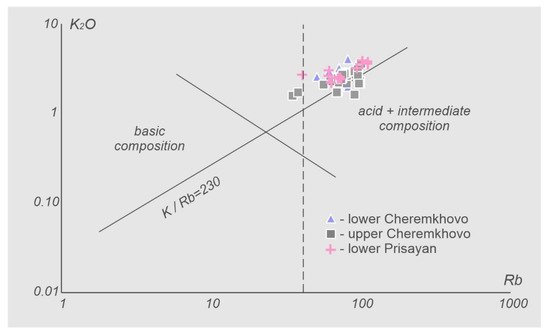
Figure 14.
The Rb versus K2O plot (after [50]).
4. Discussion
The Cheremkhovo Fm. is considered to belong to either the Pliensbachian [3], Pliensbachian–Toarcian [2,4] or Pliensbachian–Aalenian [5] intervals by biostratigraphy. The upper Cheremkhovo Fm. marks the lacustrine-swamp sedimentation in the wide territory of the Irkutsk coal-bearing basin. There is evidence of the presence of tuffaceous interlayers in the Cheremkhovo Fm. sediments [17,23,52]. An ash interlayer (tonstein) is present in the industrial coal seam of the Azeisk deposit in the northwest part of the basin. The tonsteins were formed due to the transformation of felsic pyroclastic material [17]. The age of the coal-bearing deposits of the Cheremkhovo Fm., represented at the Azeisk coal deposit, was established as 187.44 +0.45/−1.60 Ma using the LA-ICP-MS U-Pb method on accessory zircons from tonstein [6]. The age of the upper Cheremkhovo Fm. places the upper limit of the tectonic quiescence period before the intensification of tectonic processes in the southern mobile framing of the Siberian craton.
In the context of regional stratigraphy, the obtained age of 187.44 Ma is consistent with the valid stratigraphic scheme [2] and the research of Skoblo et al. [3] that supplements it. The coarsening of the basin’s sediments is upward through the Prisayan and Kuda Fm. According to the consistent scheme [3], the Prysayan Fm. and Kuda Fm. are Pliensbachian–Aalenian and Aalenian–Bajocian, respectively. From the lower Prisayan Fm. there are no industrial coal seams in the Irkutsk basin. The lower Prisayan Fm. is Pliensbachian–Toarcian [3].
Petrographic studies of the Irkutsk basin rocks are fully consistent with the data of previous studies [3,7,8]. The geochemical studies generally confirm this but give more detailed information. The available data indicate three major provenance areas of sediments: the Siberian Craton, the Caledonian complexes bordering the craton, and the Transbaikalia region [12,18]. The evolution of the relief near the southern part of the Siberian Craton depended on the subduction of the Mongol-Okhotsk oceanic slab [53]. Data in the Irkutsk basin confirmed the coarsening of sediments upward through the Prisayan and Kuda Fm. This fact, with an increase in 143Nd/144Nd ratios and the Jurassic-age detrital zircons, was associated with the closure of the Mongol-Okhotsk Ocean [12,54]. To mark the provenance area for the Cheremkhovo Fm., isotope-geochemistry and geochronological studies are required.
An understanding of coal deposits demands wider perspectives of the processes in sedimentary settings. Coal-depositional environments significantly influence coal’s characteristics [55]. Different geochemical parameters have been used as indicators for the depositional environment during or shortly after coal accumulation. The climate change in Toarcian led to an almost complete stop in the processes of coal accumulation in the Irkutsk basin.
5. Conclusions
This study presents geochemical data on Jurassic deposits of the Cheremkhovo and lower Prisayan formations from the Irkutsk coal-bearing basin. Based on the chemical composition of siliciclastic rocks, the Cheremkhovo and the lower Prisayan formations are classified as graywacke, arkose, and litharenite.
CIA and PIA, Rb/Sr, and Sr/Cu ratios showed the event of climate change within the sedimentation of the Irkutsk coal-bearing basin deposits. The Cheremkhovo Fm. prevails in a warm, humid climate, and we see a high grade of chemical weathering of the source rocks. The indicators used revealed the change in climate from warm and humid to hot and arid during the deposition of the lower Prisayan Fm.
The provenance of the Irkutsk coal-bearing basin was influenced by the source composition, not recycling. The studied sediments were deposited due to the destruction of mainly felsic to intermediate igneous rocks.
Supplementary Materials
The following are available online at https://www.mdpi.com/article/10.3390/min11040357/s1, Table S1: The table with the sampling locations, major element oxide, and trace element concentrations for the Cheremkhovo Fm. and lower Prisayan Fm. from the Irkutsk coal-bearing basin.
Author Contributions
Conceptualization, A.V.I., E.I.D., E.A.M.; methodology, E.I.D. and E.A.M.; software, E.A.M.; validation, E.I.D. and A.V.I.; formal analysis, E.I.D. and E.A.M.; investigation, E.I.D. and E.A.M.; resources, E.I.D. and E.A.M.; data curation, E.I.D. and E.A.M.; writing—original draft preparation, E.A.M.; writing—review and editing, E.I.D. and A.V.I.; visualization, E.A.M. and E.I.D.; supervision, E.I.D. and A.V.I.; project administration, E.I.D.; funding acquisition, E.A.M. All authors have read and agreed to the published version of the manuscript.
Funding
The reported study was funded by RFBR and the Government of the Irkutsk Region, project number 20-45-383008.
Data Availability Statement
Not applicable.
Acknowledgments
Laboratory investigations were carried out at the Center for Geodynamics and Geochronology of the Institute of the Earth’s Crust of Siberian Branch of the Russian Academy of Sciences (Irkutsk, Russia). The authors are grateful to the reviewers’ valuable comments that improved the paper.
Conflicts of Interest
The authors declare no conflict of interest.
References
- Cherepovskij, V. The Coal Resources of Russia; Geoinformcentre Publ.: Moscow, Russia, 2002; Volume 3. (In Russian) [Google Scholar]
- Saks, V.N.; Gol’bert, A.V.; Dagis, A.S.; Mesezhnikov, M.S.; SHackij, S.B. Explanatory note to the regional stratigraphic patterns of the Mesozoic and Cenozoic of Central Siberia. In Proceedings of the Interagency Stratigraphic Meeting, Novosibirsk, Russia, 13–17 November 1978; p. 46. (In Russian). [Google Scholar]
- Skoblo, V.; Lyamina, N.; Rudnev, A.; Luzina, I. Continental Upper Mesozoic of Cisbaikalia and Transbaikalia (Stratigraphy, Depositional Conditions, Correlations); Izdatel’stvo Sibirskogo Otdeleniya Rossiiskoi Akademii Nauk: Novosibirsk, Russia, 2001. (In Russian) [Google Scholar]
- Akulov, N.I.; Frolov, A.O.; Mashchuk, I.M.; Akulova, V.V. Jurassic Deposits of the Southern Part of the Irkutsk Sedimentary Basin. Stratigr. Geol. Correl. 2015, 23, 387–409. [Google Scholar] [CrossRef]
- Kiritchkova, A.I.; Kostina, E.I.; Nosova, N.V. Jurassic continental deposits in the sections of the Irkutsk Coal Basin stratoregion. Stratigr. Geol. Correl. 2017, 25, 492–514. [Google Scholar] [CrossRef]
- Mikheeva, E.A.; Demonterova, E.I.; Khubanov, V.B.; Ivanov, A.V.; Arzhannikova, A.V.; Arzhannikov, S.G.; Blinov, A.V. Age of the coal accumulation in the Irkutsk basin based on accessory zircon dating in the Azeisk deposit tonstein (LA-ICP-MS). Vestn. St. Petersb. Univ. Earth Sci. 2020, 65, 19. [Google Scholar] [CrossRef]
- Odintsov, M.; Kashik, S.; Il’yukhina, A. Jurassic Continental Deposits in the South of the Siberian Platform; Nauka Publisher: Moscow, Russia, 1967. (In Russian) [Google Scholar]
- Timofeev, P. Geology and Facies of the Jurassic Coal-Bearing Formation in Southern Siberia; Nauka: Moscow, Russia, 1970. (In Russian) [Google Scholar]
- Fainshtein, G.K. Jurassic paleogeography of the Irkutsk amphitheatre in relation to its exogenic ore bearance. In Materialy po Geologii i Poleznym Iskopaemym Sibirskoi Platformy; Nedra: Moscow, Russia, 1971; pp. 55–68. (In Russian) [Google Scholar]
- Adamenko, O.; Dolgushin, I.Y.; Ermolov, E.; Isaeva, L.; Kozlovskaya, S.; Leonov, B.; Tseitlin, S. Highlands and Lowlands of Eastern Siberia; Nauka: Moscow, Russia, 1971. (In Russian) [Google Scholar]
- Akulov, N.I.; Melnikov, A.I.; Shtelmakh, S.I.; Akulova, V.V.; Hearn, P.P. A geochemical and lithological correlation of lower Jurassic conglomerates in the area surrounding the Lake Baikal rift zone: An improved reconstruction of the region’s palaeogeographic and tectonic evolution. Int. Geol. Rev. 2021, 1–16. [Google Scholar] [CrossRef]
- Demonterova, E.I.; Ivanov, A.V.; Mikheeva, E.M.; Arzhannikova, A.V.; Frolov, A.O.; Arzannikov, S.G.; Bryanskiy, N.V.; Pavlova, L.A. Early to Middle Jurassic history of the southern Siberian continent (Transbaikalia) recorded in sediments of the Siberian Craton: Sm-Nd and U-Pb provenance study. Bull. Soc. Geol. France 2017, 188, 29. [Google Scholar] [CrossRef]
- Arzhannikova, A.V.; Frolov, A.O.; Arzhannikov, S.G.; Demonterova, E.I.; Ivanov, A.V.; Jolivet, M.; Rubtsova, M.N.; Dorozhko, A.L. Jurassic sediments in the Irkut basin and southwestern Transbaikalia: Correlations based on paleobotanical and geochronological data. Russ. Geol. Geophys. 2018, 59, 620–634. [Google Scholar] [CrossRef]
- Frolov, A.O.; Mashchuk, I.M. A New Species of the Genus Phoenicopsis (Leptostrobales) from the Middle Jurassic of the Irkutsk Basin (Eastern Siberia). Paleontol. J. 2018, 52, 463–468. [Google Scholar] [CrossRef]
- Frolov, A.; Mashchuk, I. Jurassic Flora and Vegetation of the Irkutsk Coal Basin. Irkutsk: Institut Geografii im; VB Sochavy SO RAN Press: Irkutsk, Russia, 2018. (In Russian) [Google Scholar]
- Akulov, N.I.; Mel’nikov, A.I.; Akulova, V.V.; Rubtsova, M.N.; Shtel’makh, S.I. Angara-Selenga Imbricate Fan Thrust System. Russ. Geol. Geophys. 2020, 61, 1–13. [Google Scholar] [CrossRef]
- Arbuzov, S.I.; Mezhibor, A.M.; Spears, D.A.; Ilenok, S.S.; Shaldybin, M.V.; Belaya, E.V. Nature of tonsteins in the Azeisk deposit of the Irkutsk Coal Basin (Siberia, Russia). Int. J. Coal Geol. 2016, 153, 99–111. [Google Scholar] [CrossRef]
- Mikheeva, E.A.; Demonterova, E.I.; Frolov, A.O.; Arzhannikova, A.V.; Arzhannikov, S.G.; Cherkashina, T.Y.; Ivanov, A.V. Provenance Change in the Irkutsk Coal Basin during the Early and Middle Jurassic: Geochemical and Sm-Nd Isotope Evidence. Stratigr. Geol. Correl. 2017, 25, 363–384. [Google Scholar] [CrossRef]
- Sell, B.; Ovtcharova, M.; Guex, J.; Bartolini, A.; Jourdan, F.; Spangenberg, J.E.; Vicente, J.-C.; Schaltegger, U. Evaluating the temporal link between the Karoo LIP and climatic–biologic events of the Toarcian Stage with high-precision U–Pb geochronology. Earth Planet. Sci. Lett. 2014, 408, 48–56. [Google Scholar] [CrossRef]
- Burgess, S.D.; Bowring, S.A.; Fleming, T.H.; Elliot, D.H. High-precision geochronology links the Ferrar large igneous province with early-Jurassic ocean anoxia and biotic crisis. Earth Planet. Sci. Lett. 2015, 415, 90–99. [Google Scholar] [CrossRef]
- Ivanov, A.V.; Meffre, S.; Thompson, J.; Corfu, F.; Kamenetsky, V.S.; Kamenetsky, M.B.; Demonterova, E.I. Timing and genesis of the Karoo-Ferrar large igneous province: New high precision U-Pb data for Tasmania confirm short duration of the major magmatic pulse. Chem. Geol. 2017, 455, 32–43. [Google Scholar] [CrossRef]
- Rybakov, V.; Hobotova, N. State Geological Map of the Russian Federation. Scale 1: 200,000; Angarskaya Series; Sheet N-48-XXXIII; Explanatory Note; Vsegei, M., Ed.; MF VSEGEI: Moscow, Russia, 2013; p. 186. (In Russian) [Google Scholar]
- Galimova, T.F.; Permyakov, S.A.; Bobrovsky, V.T.; Pashkova, A.G.; Bormotkina, L.A.; Povarintseva, S.A.; Matveichuk, A.A.; Namolova, M.M.; Sadriev, V.M. State Geological Map of the Russian Federation. Scale 1: 1,000,000 (Third Generation); Angara-Yenisei Series; Sheet N-48; Ministry of Natural Resources of Russia, FGUNPGP and “Irkutskgeofizika”, Eds.; VSEGEI Cartographic Factory: St. Petersburg, Russia, 2009; p. 574. (In Russian) [Google Scholar]
- Gutova, L. On the Stratigraphy of Jurassic Deposits of the Irkutsk Coal Bearing Basin; Tr. Inst. Zemnoi Kory SO AN SSSR: Irkutsk, Russia, 1963; pp. 92–99. (In Russian) [Google Scholar]
- Ankudimova, L.; Shurygin, B.; Kabanova, G.; Odintsova, M. Stratigraphic scheme of Jurassic Deposits in the Irkutsk Coal bearing Basin. In Organicheskii mir Vostochnoi Sibiri v Fanerozoe; Nauka: Novosibirsk, Russia, 1982; pp. 30–42. (In Russian) [Google Scholar]
- Shtel’makh, S.; Cherkashina, T.Y.; Pashkova, G. X-ray fluorescence determination of trace elements in carbonaceous rock and fluorite ore using S8 TIGER spectrometer. Anal. Kontrol 2015, 121–129. [Google Scholar] [CrossRef][Green Version]
- SPECTRAplus. Software Package for X-ray Spectrometers; Version 2.2.3.1; Bruker AXS GmbH: Karlsruhe, Germany, 2010. [Google Scholar]
- Goldberg, K.; Humayun, M. The applicability of the Chemical Index of Alteration as a paleoclimatic indicator: An example from the Permian of the Paraná Basin, Brazil. Palaeogeogr. Palaeoclimatol. Palaeoecol. 2010, 293, 175–183. [Google Scholar] [CrossRef]
- Pettijohn, F.J. Sedimentary Rocks; Harper & Row New York: New York, NY, USA, 1975; Volume 3. [Google Scholar]
- Nesbitt, H.; Young, G. Early Proterozoic climates and plate motions inferred from major element chemistry of lutites. Nature 1982, 299, 715–717. [Google Scholar] [CrossRef]
- McLennan, S.M. Weathering and global denudation. J. Geol. 1993, 101, 295–303. [Google Scholar] [CrossRef]
- Fedo, C.M.; Wayne Nesbitt, H.; Young, G.M. Unraveling the effects of potassium metasomatism in sedimentary rocks and paleosols, with implications for paleoweathering conditions and provenance. Geology 1995, 23, 921–924. [Google Scholar] [CrossRef]
- Parker, A. An Index of Weathering for Silicate Rocks. Geol. Mag. 1970, 107, 501–504. [Google Scholar] [CrossRef]
- Harnois, L. The CIW index: A new chemical index of weathering. Sediment. Geol. 1988, 55, 319–322. [Google Scholar] [CrossRef]
- Hamdan, J.; Bumham, C.P. The contribution of nutrients from parent material in three deeply weathered soils of Peninsular Malaysia. Geoderma 1996, 74, 219–233. [Google Scholar] [CrossRef]
- Price, J.R.; Velbel, M.A. Chemical weathering indices applied to weathering profiles developed on heterogeneous felsic metamorphic parent rocks. Chem. Geol. 2003, 202, 397–416. [Google Scholar] [CrossRef]
- Hofer, G.; Wagreich, M.; Neuhuber, S. Geochemistry of fine-grained sediments of the upper Cretaceous to Paleogene Gosau Group (Austria, Slovakia): Implications for paleoenvironmental and provenance studies. Geosci. Front. 2013, 4, 449–468. [Google Scholar] [CrossRef]
- Krzeszowska, E. Geochemistry of the Lublin Formation from the Lublin Coal Basin: Implications for weathering intensity, palaeoclimate and provenance. Int. J. Coal Geol. 2019, 216, 103306. [Google Scholar] [CrossRef]
- McLennan, S.; Hemming, S.; McDaniel, D.; Hanson, G. Geochemical Approaches to Sedimentation, Provenance, and Tectonics; Special Papers; Geological Society of America: Boulder, CO, USA, 1993; p. 21. [Google Scholar]
- Lerman, A.; Imboden, D.M.; Gat, J.R.; Chou, L. Physics and Chemistry of Lakes; Springer: Berlin/Heidelberg, Germany, 1995. [Google Scholar]
- Bai, Y.; Liu, Z.; Sun, P.; Liu, R.; Hu, X.; Zhao, H.; Xu, Y. Rare earth and major element geochemistry of Eocene fine-grained sediments in oil shale- and coal-bearing layers of the Meihe Basin, Northeast China. J. Asian Earth Sci. 2015, 97, 89–101. [Google Scholar] [CrossRef]
- Tao, S.; Xu, Y.; Tang, D.; Xu, H.; Li, S.; Chen, S.; Liu, W.; Cui, Y.; Gou, M. Geochemistry of the Shitoumei oil shale in the Santanghu Basin, Northwest China: Implications for paleoclimate conditions, weathering, provenance and tectonic setting. Int. J. Coal Geol. 2017, 184, 42–56. [Google Scholar] [CrossRef]
- Chen, J.; An, Z.; Head, J. Variation of Rb/Sr Ratios in the Loess-Paleosol Sequences of Central China during the Last 130,000 Years and Their Implications for Monsoon Paleoclimatology. Quat. Res. 1999, 51, 215–219. [Google Scholar] [CrossRef]
- Xu, H.; Liu, B.; Wu, F. Spatial and temporal variations of Rb/Sr ratios of the bulk surface sediments in Lake Qinghai. Geochem. Trans. 2010, 11, 3. [Google Scholar] [CrossRef]
- Bhatia, M.R. Plate Tectonics and Geochemical Composition of Sandstones. J. Geol. 1983, 91, 611–627. [Google Scholar] [CrossRef]
- Bhatia, M.R.; Crook, K.A. Trace element characteristics of graywackes and tectonic setting discrimination of sedimentary basins. Contrib. Mineral. Petrol. 1986, 92, 181–193. [Google Scholar] [CrossRef]
- Roser, B.P.; Korsch, R.J. Provenance signatures of sandstone-mudstone suites determined using discriminant function analysis of major-element data. Chem. Geol. 1988, 67, 119–139. [Google Scholar] [CrossRef]
- Cox, R.; Lowe, D.R.; Cullers, R.L. The influence of sediment recycling and basement composition on evolution of mudrock chemistry in the southwestern United States. Geochim. Cosmochim. Acta 1995, 59, 2919–2940. [Google Scholar] [CrossRef]
- Lee, Y.I. Provenance derived from the geochemistry of late Paleozoic–early Mesozoic mudrocks of the Pyeongan Supergroup, Korea. Sediment. Geol. 2002, 149, 219–235. [Google Scholar] [CrossRef]
- Floyd, P.A.; Winchester, J.A.; Park, R.G. Geochemistry and tectonic setting of Lewisian clastic metasediments from the Early Proterozoic Loch Maree Group of Gairloch, NW Scotland. Precambr. Res. 1989, 45, 203–214. [Google Scholar] [CrossRef]
- Taylor, S.R.; McLennan, S.M. The Continental Crust: Its Composition and Evolution; Blackwell Scientific Publications: Hoboken, CJ, USA, 1985. [Google Scholar]
- Kiziyarov, G.; Meshalkin, S. The first finding of volcanic tuff in the Jurassic of the Irkutsk coal-bearing basin. Russ. Geol. Geophys. 1978, 2, 138–141. [Google Scholar]
- Donskaya, T.V.; Gladkochub, D.P.; Mazukabzov, A.M.; Ivanov, A.V. Late Paleozoic—Mesozoic subduction-related magmatism at the southern margin of the Siberian continent and the 150 million-year history of the Mongol-Okhotsk Ocean. J. Asian Earth Sci. 2013, 62, 79–97. [Google Scholar] [CrossRef]
- Arzhannikova, A.V.; Demonterova, E.I.; Jolivet, M.; Arzhannikov, S.G.; Mikheeva, E.A.; Ivanov, A.V.; Khubanov, V.B.; Pavlova, L.A. Late Mesozoic topographic evolution of western Transbaikalia: Evidence for rapid geodynamic changes from the Mongol–Okhotsk collision to widespread rifting. Geosci. Front. 2020, 11, 1695–1709. [Google Scholar] [CrossRef]
- Dai, S.; Bechtel, A.; Eble, C.F.; Flores, R.M.; French, D.; Graham, I.T.; Hood, M.M.; Hower, J.C.; Korasidis, V.A.; Moore, T.A.; et al. Recognition of Peat Depositional Environments in Coal: A Review; Elsevier B.V.: Amsterdam, The Netherlands, 2020; Volume 219, p. 103383. [Google Scholar] [CrossRef]
Publisher’s Note: MDPI stays neutral with regard to jurisdictional claims in published maps and institutional affiliations. |
© 2021 by the authors. Licensee MDPI, Basel, Switzerland. This article is an open access article distributed under the terms and conditions of the Creative Commons Attribution (CC BY) license (http://creativecommons.org/licenses/by/4.0/).